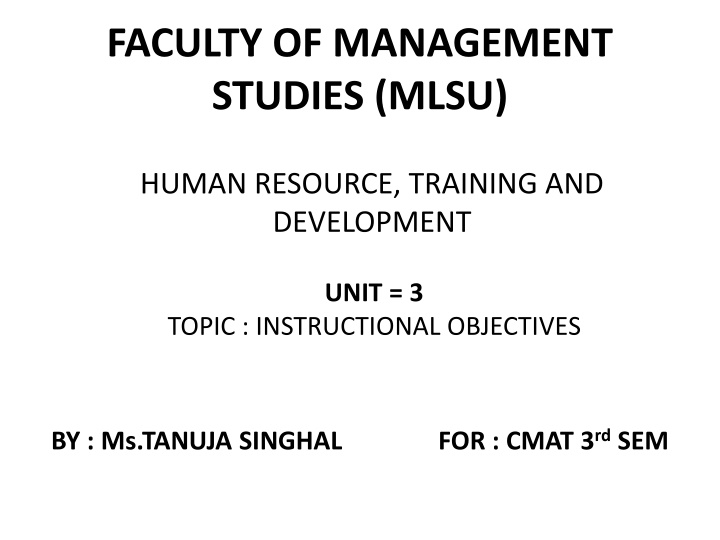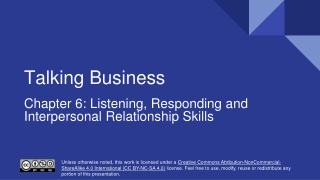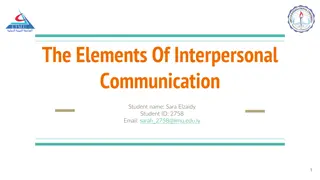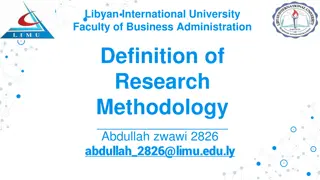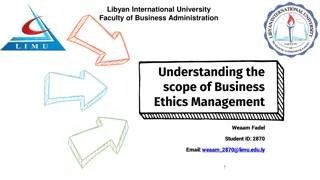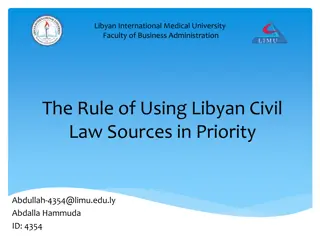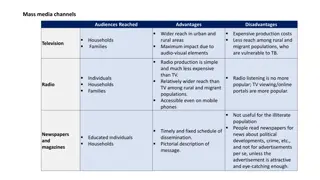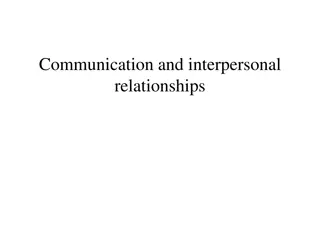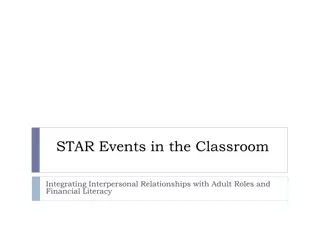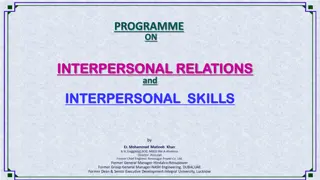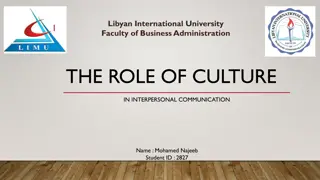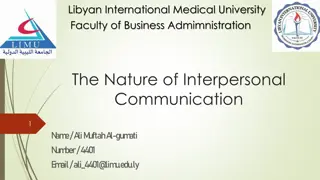The Nature of Interpersonal Communication at Libyan International Medical University
Interpersonal communication involves verbal and nonverbal cues such as tone, body language, and facial expressions. It plays a crucial role in personal and professional relationships, enhancing understanding and empathy. This article delves into the definition, types, examples, importance, acquired skills, and commandments to improve interpersonal communication.
Download Presentation

Please find below an Image/Link to download the presentation.
The content on the website is provided AS IS for your information and personal use only. It may not be sold, licensed, or shared on other websites without obtaining consent from the author.If you encounter any issues during the download, it is possible that the publisher has removed the file from their server.
You are allowed to download the files provided on this website for personal or commercial use, subject to the condition that they are used lawfully. All files are the property of their respective owners.
The content on the website is provided AS IS for your information and personal use only. It may not be sold, licensed, or shared on other websites without obtaining consent from the author.
E N D
Presentation Transcript
FACULTY OF MANAGEMENT STUDIES (MLSU) HUMAN RESOURCE, TRAINING AND DEVELOPMENT UNIT = 3 TOPIC : INSTRUCTIONAL OBJECTIVES BY : Ms.TANUJA SINGHAL FOR : CMAT 3rd SEM
WHAT IS AN INSTRUCTIONAL OBJECTIVE An instructional objective is a statement that will describe what the learner will be able to do after completing the instruction. (Kibler, Kegla, Barker, Miles, 1974). Robert Mager (1984), in his book Preparing Instructional Objectives, describes an objective as "a collection of words and/or pictures and diagrams intended to let others know what you intend for your students to achieve"
CHARACTERISTICS OF INSTRUCTIONAL OBJECTIVES An easy way to remember the characteristics of a good objective, is the acronym, "SMART." It stands for Specific Measureable Attainable Realistic Time bound
COMPONENTS There are four components of an objective: 1) the action verb 2) conditions 3) standard 4) the intended audience
DR. BENJAMIN BLOOM Dr. Benjamin Bloom (February 21,1913- September 13,1999) American Educational Psychologist Classification of Educational Objectives Theory of mastery-learning Research team under his supervision has developed a taxonomy of Educational Objectives in 1956
BLOOMS TAXONOMY OF INSTRUCTIONAL OBJECTIVES Taxonomy simply means Classification The purpose of Bloom s Taxonomy is to promote higher forms of thinking in education such as analyzing and evaluating concepts, processes, procedures, and principles, rather than just remembering facts (rote learning). It is often used when designing instruction or learning processes (instructional Design)
THE THREE DOMAINS OF LEARNING Cognitive: mental skills (knowledge) Head Affective: growth in feelings or emotional areas (attitude or self) Heart Psychomotor: manual or physical skills (skills) Hands
BLOOMS REVISED TAXONOMY Lorin Anderson and David Krathwohl (former students) revisited the Cognitive Domain in mid-nineties and made some changes in it.
THE COGNITIVE DOMAIN Bloom s Taxonomy: The Cognitive Domain The cognitive domain involves knowledge and the development of intellectual skills (Bloom, 1956). There are six major categories of cognitive a process, starting from the simplest to the most complex. Knowledge Remembering Comprehension Understanding Application Applying Analysis Analyzing Synthesis Creating Evaluation Evaluating
VERBS SUITABLE FOR COGNITIVE DOMAIN Remembering (define, describe, identify, know, label, list, match, name, outline, recall etc.) Understanding comprehends, converts, defends, distinguishes, estimates, explains, extends Applying operates, predicts, prepares, produces, relates, shows, solves, uses Analyzing analyzes, breaks down, compares, contrasts, diagrams, deconstructs, differentiates Evaluating evaluates, explains, interprets, justifies, relates, summarizes, supports Creating generates, modifies, organizes, plans, rearranges, reconstructs
BLOOMS TAXONOMY : AFFECTIVE DOMAIN The affective domain(Krathwohl, Bloom, Masia, 1973) includes the manner in which we deal with things emotionally, such as feelings, values, appreciation, enthusiasm, motivation and attitude The five major categories are listed from the simplest behavior to the most complex Receiving Responding Valuing Organizing characterization
VERBS SUITABLE FOR AFFECTIVE DOMAIN Receiving acknowledge-, asks, attentive, courteous, dutiful, follows, gives, listens, understands Responding answers-, assists, aids, complies, conforms, discuss, performs, presents, tells Valuing appreciates-, cherish, treasure, demonstrates, initiates, invites, joins, justifies, proposes, Organization compares-, relates, synthesizes Characterization acts-, discriminates, displays, influences, modifies, performs, qualifies
BLLOMS TAXONOMY : THE PHYCHOMOTOR DOMAIN The psychomotor domain (Simpson, 1972) includes physical movement, coordination, and use of the motor- skill areas. Psychomotor skills rage from manual tasks. The major levels of Psychomotor Domain are Perception (awareness through sensory cues) Set Guided Response Mechanism (basic proficiency) Complex Overt response (Expert) Adaptation Organization
VERBS SUITABLE FOR PHYCHOMOTOR DOMAIN Perception- chooses, describes, detects, differentiates, distinguishes, identifies Set- proceeds, reacts, shows, states, volunteers. Guided Response- copies, traces, follows, react, reproduce, responds Mechanism (basic proficiency)- assembles, calibrates, constructs, dismantles, displays Complex overt Response (Expert)- manipulates, measures, mends, mixes, organizes, sketches. Adaptation- adapts, alters, changes, rearranges, reorganizes, revises Organization- constructs, creates, designs, initiate, makes, originates
WHY TO USE IT Some of the reasons for employing Bloom s Taxonomy include Accurately measuring of Students abilities Establishes intended learning outcomes in professor/student interactions Helps faculty to design and implement appropriate assessment tasks, measures, and instruments. Helps to ensure that instruction and assessment are appropriately aligned with the intended outcomes
